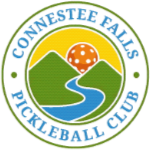Serving/Scoring Rules:
*A volley serve (made without bouncing the ball) must be underhand. The server’s arm must move in an upward arc at the time the ball is struck and must be below the server’s waist. The highest point of the paddle head must not be above the highest part of the wrist when the paddle strikes the ball.
*For a bounce serve, restrictions are lifted but you must release the ball from one hand or drop it from your paddle face; you may not toss it upward or propel it downward.
*The server must serve to the correct service court (diagonally opposite). The serve may clear or touch the net but must clear the non volley zone and the NVZ line. The serve may land on any other service court line.
*Neither of the server’s feet may touch the area outside the imaginary lines extending back from the center and side lines. Additionally, the server’s feet may not touch the court itself or the baseline.
*Once the score is called, the server has 10 seconds to serve.
*If the server begins the service motion before the entire score is called, it’s a service fault.
*The server should call the score, but the server’s partner may call the score. This should not change throughout the game.
Wrong Score Called:
*If the server calls the wrong score, any player may stop play before the return of the serve and ask for it to be corrected. If the score is incorrect, it will be corrected and the ball will be re-served with no penalty. If the score was correct and the receiver stopped play, the point goes to the serving team.
Readiness:
*To indicate that you’re not ready as the receiver, one of the following signals should be used: 1/raise paddle above your head, 2/ raise non paddle hand above your head, 3/ turn your back to the net.
Line Calls:
*You may only make a line call for a ball on your side of the net unless asked by your opponents. Should you ask the opponent’s opinion on a line call and the opponent makes a clear “in” or “out” call, it must be accepted. If the opponents cannot make a clear “in” or “out” call, then the ball is “in”.
*If you’re not 100 percent certain the ball is out, it’s in! If you and your partner don’t agree, the ball is in!
*A ball should not be called out unless the player can clearly see a space between the line and the ball. This means a ball could be considered in even if it wasn’t touching the line.
*Players should not call a ball “out” when looking across a line unless they can clearly see a space between the line and the ball as it hits. The player’s depth-of-field judgment, based on the laws of parallax, prevents accurate judgment in these cases.
*If you call the ball out BEFORE it bounces it is considered player communication. If you call it out AFTER it bounces it is considered a line call and may not be retracted by either you or your partner. Once an out call is made for a ball after the bounce it is a dead ball.
Hits:
*You are allowed to hit the ball with any part of your hand holding the paddle provided it is below the wrist.
*You may hit the ball around the post, known as an ATP.
*If the ball hits a player before it bounces in the court, the point goes to the other side. This includes on the serve and if you’re standing off the court.
*If there is a distraction on the court in the middle of the play of a point, a player may stop play and ask for a replay. Note, a player should only ask for a replay if the distraction impacted play. If your opponent makes a put away that you’d never have gotten, you should not ask for a replay in the interest of good sportsmanship.
Double Hits:
* Balls can be hit twice, but this must occur during an unintentional, continuous, single-direction stroke, by one player. If the stroke is deliberate, or not continuous, or not in a single direction, or the ball is struck by a second player, it is a fault.
Incorrect position as serving or receiving team:
*You may stop play in the middle of the point in which case it’s a replay if the incorrect position was correctly identified. If you stopped play and the opponents were in the correct positions you would lose the point.
*If the rally has concluded, the point stands as played and players must continue play from the correct positions.
Kitchen (Non volley zone) Rules:
*No part of you, your paddle, or anything you’re wearing can touch the ground within the non-volley zone while volleying the ball. Both feet must be re-grounded outside the non-volley zone before volleying the ball again. It is a fault if your momentum carries you, your paddle or your equipment into the kitchen.
Should you have any questions feel free to contact Debbie Dove at debdove@gmail.com
